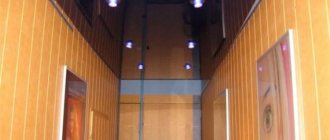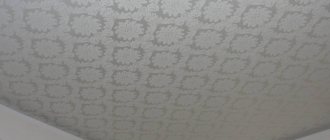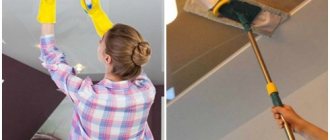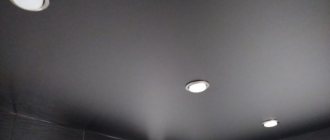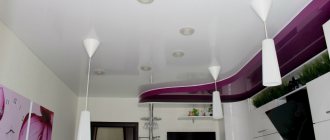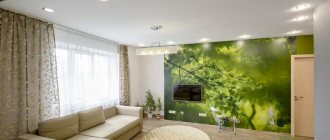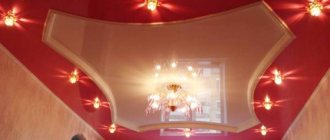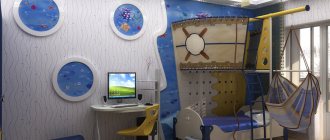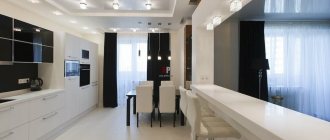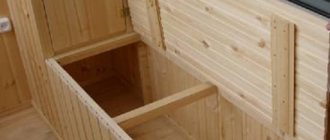Many people think about how to make a ceiling in a private house. Taking into account the huge range of materials and finishing methods, this question sounds quite relevant. You need to choose taking into account both technical characteristics and appearance. The ceiling is the most noticeable place in the room, and therefore, first of all, a person’s gaze is drawn to it.
Material selection criteria
The choice of materials for the manufacture and arrangement of the ceiling should be based on taking into account the main influencing factors, as well as ensuring adequate comfort and ease of maintenance. All air currents from the inside, supplemented by human waste products, rush towards it.
He can also feel the impact from above when the roof cannot cope with heavy rainfall or something spills in the attic. The following main criteria for choosing materials for ceilings can be distinguished:
- Moisture resistance . This requirement is important for all premises, in particular for the possibility of wet cleaning or when water leaks from above. It is especially acute in relation to ceiling materials for bathrooms, bathrooms and kitchens.
- Sanitary and hygienic requirements. The material must be absolutely harmless to humans even at elevated temperatures. It should not contribute to the development of mold, fungi, or the proliferation of pathogenic microorganisms.
- Easy to care for. The ceiling should not strongly attract dust and accumulate dirt. It’s good when cleaning can be done using conventional means.
- Durability. During operation, the color should not change (yellowness, blackening, etc.). The material must not be subject to chemical or biological degradation. It is unacceptable for peeling finish to fall from the ceiling.
- Aesthetics. Appearance sometimes plays a decisive role in the choice of material. Originality and the possibility of various design solutions are valued.
Increased demands are placed on ceilings in the kitchen and bathroom . In the first case, when cooking, steam with fatty components rises, which settle on the surface of the ceiling.
In addition, when gas burns, there are combustion products that are also capable of aggressive effects. In the bathroom, high humidity is added to high temperatures, temperature changes and splashing water. All of these factors must be taken into account when choosing ceiling materials.
[custom_ads_shortcode1]
Main types of ceiling coverings
Based on design features, the following main types of ceilings can be distinguished:
- Basic (plaster) construction - a ceiling surface without additional load-bearing elements, finished by applying a finishing coating (pasting, painting, whitewashing). The ceiling is first plastered.
- Tension systems . The front side of such a ceiling is formed from stretched fabric. In this case, usually no surface finishing is used.
- Suspended design. It provides a supporting frame, which is fixed to the ceiling. On it another solid surface is formed from sheets, slabs, panels, boards or slats. Such systems may have one or several levels.
Each type of ceiling has its pros and cons. In particular, the basic type requires careful leveling of the surface. The other two options can be used in the presence of large irregularities, i.e.
are able to disguise them. At the same time, they “eat up” the height of the room.
[custom_ads_shortcode2]
Basic work
Most often, ceiling finishing is achieved by carefully leveling the surface and then applying a finishing coating that provides an attractive appearance and a certain design style. The most common methods are:
- Whitewash for plaster ceilings. First, the surface is leveled by puttying, priming and plastering. The process itself involves applying chalk or lime mortar. You can use a white background or tint with various pigments. The main advantages are the possibility of finishing it yourself, the low cost of the method and environmental friendliness. The ceiling is breathable. Lime whitewash has bactericidal properties. The disadvantages of whitewashing are the need to perfectly level the ceiling, fragility (the need to update the whitewash after 3-4 years), low moisture resistance, rapid contamination and problems with cleaning.
- Painting. This is the second most common method of finishing the ceiling. The most commonly used is water-based paint. It has all the main advantages of whitewashing, and at the same time has a certain moisture resistance. The painted ceiling can be wet cleaned using detergents. Other disadvantages of whitewashing are transferred to painting. In addition, the ceiling loses its “breathing effect”.
- Decorative plaster. The most popular is considered to be textured type plaster (it can be called structural, plaster, etc.). It contains a special filler with grains of various fractions. Using a textured solution, relief patterns are created. This finishing increases the decorative value of the ceiling and makes it possible to imitate stucco in a classic style. Disadvantages - increased cost and the impossibility of applying it yourself without special skills.
- Wallpaper. Pasting the ceiling is no different from covering the walls, except for the inconvenience of the location. Using wallpaper, you can provide its original colors (for example, imitation of natural materials). Wallpaper can mask small cracks, but in general it requires careful leveling of the surface. Washable materials can be easily cleaned with normal cleaning products.
- Tile. The ceiling can be covered with lightweight polystyrene foam tiles. Their main advantage is the provision of additional thermal insulation. The main disadvantage is flammability, with the release of harmful substances during fire. A rather expensive method, but without this drawback, is gluing glass or mirror tiles.
- Cork coverings. This applies to modern ways of arranging a room. This covering is made from sheets made from natural cork. It has a special attractiveness, increased water resistance and thermal insulation properties, but has a high cost.
- Liquid wallpaper. Essentially, this is a coating that combines the properties of wallpaper and plaster. It is made from a mixture based on cellulose fibers. The material is applied similarly to decorative plaster, and after hardening it takes the form of wallpaper. Liquid wallpaper creates a beautiful design, but is expensive.
- Stucco molding. It is most often made of plaster. Foam plastic figures are often used as imitation, which after painting are difficult to distinguish from real stucco.
In general, finishing ceilings without additional load-bearing elements is most popular, provided there is a sufficiently flat ceiling surface. Its important advantage is its small impact on the height of the room.
[custom_ads_shortcode1]
Suspension systems
Suspended or frame ceilings are needed to mask large irregularities and create original multi-level structures with a special lighting system. The following arrangement options stand out:
- Panel ceilings. They are made of plastic panels that are mounted on an aluminum profile frame. The variety of textures makes it possible to design the ceiling in different styles. The panels are absolutely moisture resistant and have a reasonable cost.
- Sheet material. A ceiling with an almost perfectly flat surface can be equipped using sheet materials. The most commonly used is plasterboard (gypsum plasterboard). It is attached to a metal or wooden sheathing, and the seams are sealed with polyurethane foam or putty. After priming the surface, such a ceiling is ready for the finishing coat.
- Cassette ceilings. This is a special system in which rectangular cells for cassettes are formed using profiles and hangers. The most common sizes of such elements are 60x60 and 60x120 cm. They can be metal, polymer, glass, wood, mirror, or mineral materials. The main advantage is the absence of rigid fastening. The cassettes are easily removed, which makes it possible to wash or replace them.
- Slatted ceilings. They look quite beautiful and have practical value, especially for rooms with high humidity. Aluminum slatted plates are used. A silver or golden hue and chrome plating add a special decorative effect.
- Wooden coverings. Wood has always been popular in the design of private homes. The fashion has not passed even today. Such methods of finishing ceilings with wooden elements are noted.
- Lining. These wooden slatted panels have long gained wide popularity. They create a natural style and a special unity with nature indoors. To protect against moisture, it is recommended to impregnate the lining with an antiseptic and varnish it.
- Continuous covering - made of boards.
Suspended ceilings often become a necessary measure to hide construction defects. They require the installation of a supporting frame, which reduces the height of the room, however, decorative possibilities make it possible to compensate for this disadvantage.
[custom_ads_shortcode2]
Ceilings in the kitchen
When planning a kitchen renovation, you need to take into account the special microclimate of this room. If you choose the wrong ceiling covering, low-quality materials or cladding, you will very soon have to redo the ceiling again. Let's look at some ideas for finishing the ceiling. The first method of finishing the ceiling can be called the simplest and least expensive - painting and whitewashing. However, this method is impractical, so we do not recommend using it unless you are ready to renew the paint every few months. You can also use decorative plaster, which is less impractical, but it may not always fit into the interior.
When choosing a ceiling finish with wallpaper or photo wallpaper, choose vinyl and washable coverings, as well as moisture-resistant adhesives. One of the most practical, albeit outdated, options are plastic panels, from which you can easily choose the size, texture or type of connection you need. They are also moisture resistant and easy to clean.
Tensile structures
Stretch ceilings are designed to perform the functions of suspension systems in terms of masking irregularities, without creating additional loads on the ceiling. Their design includes a frame mounted on the wall and a canvas stretched under the ceiling at a distance of 10-12 cm from it.
There are 2 main types of them - fabric and film ceilings. In the first case, a textile fabric woven from polyester fibers is used. In the second case, PVC film is used. The canvas is fixed at its ends in the frame and stretched tightly, forming a flat surface. When stretching the PVC film, it is heated using a heat gun.
[custom_ads_shortcode3]
Stretch ceiling systems in the kitchen
A suspended ceiling in the kitchen is quite expensive, but if installed correctly it can last a very long time. This solution completely protects the premises in case of flooding from neighbors above. The main fabric does not tear, but sags under the weight of water. After eliminating the leak, bend the corner of the tension system and drain the water using a hose.
The installation process involves the following steps:
- A closed profile is fixed along the perimeter of the walls.
- Remove existing lighting fixtures on the ceiling.
- The canvas is suspended from the profile and begins to be heated using a heat gun.
- The edges of the canvas are tucked into the profile, starting from the corners. Then they move to the sides and begin tucking from the middle.
- To install lamps or chandeliers, reinforcing rings are glued to the canvas in a certain place. They cut out the canvas inside the ring, take out the wires and mount the lighting device.
- The lower edge of the profile is covered with a special tape made of dense polyvinyl chloride.
Stretch ceilings in the kitchen are very popular due to the following advantages:
- Installation work is completed in just 3 hours.
- Defects in the main ceiling are completely hidden.
- Ability to withstand significant loads.
- Wide selection of colors, textures and patterns.
- Flame resistant.
- The operating period is up to 20 years.
- Resistant to the growth of fungus and mold, as well as the formation of corrosion.
Disadvantages:
- Installation work can only be performed by specially trained craftsmen using professional equipment.
- The height of the kitchen is reduced by at least 4 cm.
- Punctures and cuts on the canvas are almost impossible to eliminate.
- Holes for lighting fixtures can only be made once.
- Limiting the power of light sources in chandeliers and lamps.
- Cheap fabric can emit harmful substances.
When deciding on what to decorate the ceiling in the kitchen with, it is important to take many factors into account. Ideally smooth ceilings can simply be painted or whitewashed. Washable wallpaper can hide minor defects in the ceiling
Foam tiles hide more significant defects, but are not suitable for ceilings with large height differences. With the help of suspended structures, you can mask all the imperfections of the ceiling, hide communications and additionally isolate the room from extraneous noise and cold.
Washing wallpaper can hide minor defects in the ceiling. Foam tiles hide more significant defects, but are not suitable for ceilings with large height differences. With the help of suspended structures, you can mask all the imperfections of the ceiling, hide communications and additionally isolate the room from extraneous noise and cold.
Ceiling height in a private house
The height of ceilings in a private house is set based on practical considerations. However, certain rules should be followed. The minimum height is 240 cm. Below it, obvious discomfort will be felt in the house no matter the height of the inhabitants.
Determining the optimal height involves several factors. It is impossible not to take into account the distribution of heat flows. If the ceilings are too high, all the heat will go up, which will force the heating to work in increased mode. Taking convection heating into account, the optimal height is considered to be about 2.7-2.8 m.
The ceiling in the house has a special status - it is visible from any point and is under the influence of rising currents and evaporation. In order for it to always have an attractive appearance and sufficient durability, it is necessary to approach the choice of materials and design with skill. From the many possible options, you need to choose the optimal arrangement method.
What kind of ceilings are best to make in a private house? How to decorate it yourself Link to main publication
When arranging a home, many people do not treat the ceiling decoration with special care, but this is also an important part of the interior. In a private house it is possible to create any design, unlike an apartment where you are limited to neighboring rooms. But when arranging your own home, you should not only pay attention to the external component, but also to insulation. We will discuss below how and with what to decorate the ceiling in a private house with your own hands.
[custom_ads_shortcode1]
Stretch ceiling
Ceilings with tension fabric are installed according to the following algorithm:
- The first element that needs to be installed is a baguette. It is installed around the entire perimeter of the room with the minimum possible distance from the ceiling. It must be fastened at least every 25 cm. The most popular option is harpoon profiles, which securely hold the blade inserted into the groove with a rigid harpoon.
- The room is heated to 70 degrees using a heat gun. The heated canvas is stretched, and its edges are inserted into the grooves of the mounted baguette. The remaining gap is subsequently closed with skirting boards. When using plastic and polyurethane skirting boards, a small gap may remain in the structure, which can be used to install hidden LED lighting.
Types of ceilings in a private house
When it comes to decorating a private home, finishes made from natural materials immediately come to mind. And the first thing that comes to mind is a tree. There are a lot of different designs made of wood. There are plenty to choose from.
The simplest type of wood finishing is lining. Often, lining is used to cover the entire room. And then it is simply coated with varnish or paint.
You can simply sheathe the ceiling and decorate the walls with other materials. The lining creates a beautiful appearance and is easy to install. Anyone can handle this.
But prices for lining can be steep. It all depends on the type of wood and category. It is clear that the most expensive ones have the best qualities.
But there are also plenty to choose from among the cheaper ones. The disadvantage of lining is that it is difficult to combine with other materials. Either cover the room completely, or carefully select types of finishes for other surfaces.
Another type of wooden ceilings is a slatted structure. The price for them, as in the previous one, depends on the breed. Here you have to choose based on your own financial capabilities. Accordingly, the characteristics will vary depending on the price. Some breeds are not afraid of moisture, others are afraid of high temperatures. In this case, everything is individual. Depending on the room in which you want to install a wooden ceiling, consult with specialists which type is right for you.
Coffered wooden ceilings rarely fit into the interior of a city apartment, but in a private house they will look chic. And immediately the main drawback is the price. Such ceilings will cost you very much.
Designers do not recommend installing them in rooms with ceilings below 3 meters. Coffered ceilings are a fairly heavy structure with many decorative elements; such a design will not look good in a small room.
When using wood, pay attention to the composition of the impregnations with which it was treated. They should not contain toxic substances, otherwise it will negate the entire environmental friendliness of the tree and may be harmful to health.
Rack structures can be made not only of wood, but also of plastic and metal. And coffered ceilings can be made of plasterboard or plastic. In appearance the differences are significant. Wood is easier to fit into the interior of a private home, but plastic and metal can also be suitable in different designs.
All materials are significantly inferior to wood. Less environmentally friendly, shorter service life. Plastic tends to turn yellow and fade in the sun.
Drywall is afraid of water. It all depends on the quality of the material and the execution of the work. There are types of plastic that differ in quality, but they will not be cheap.
An alternative option is suspended ceilings. A very good way to decorate the ceiling. It will disguise all its shortcomings and hide communications. In private houses, the premises are much more often larger in area than in apartments.
When installing a stretch ceiling in large rooms, the canvas is welded together, which forms a seam. If the masters cheat, then it can be very visible. Therefore, pay attention to this point. This applies to PVC fabric, but fabric fabric does not have this drawback, so it is more advisable to use it.
An exclusive type of finishing that is not suitable for apartments is glass ceiling decoration. Creating such a design yourself will not turn out to be a very complex installation. The cost can be staggering.
But this ceiling is incredibly beautiful. Its advantages include ease of cleaning and long service life.
Paint finishing is still the most budget option. I don't want to use this option in my home. But if you still decide, then choose high-quality paint.
Be sure to prime first. Treat with an antifungal compound and carefully level the ceiling, otherwise you will have a crooked surface.
In addition to choosing materials, it is important to choose the right interior, and in your own home the choice of options is much wider than in an apartment. To expand the space, the ceiling can be made in the form of an arch, this will add a touch of sophistication. Sloping ceiling. It is often done on the roof, but sometimes it is used in large but narrow rooms to equalize the space.
[custom_ads_shortcode2]
Ceilings in the apartment and on the ground floor of the house
In areas where insulation is not required, there are many more options to choose from. Before deciding which ceiling is best for a particular case, you should learn about the pros and cons of existing solutions.
Option #1: using wallpaper
There is a huge amount of wallpaper that allows you to create coatings that, at first glance, are completely different from the usual finishing material. Non-woven, paper, liquid and even glass wallpapers are used for ceilings.
Important! This option can only be used on perfectly flat surfaces.
Among the advantages of this method is that repairs are easy to do yourself. There are other advantages:
- a huge selection of patterns and textures;
- low cost;
- installation speed - in just 1-2 days you can create a ceiling in all rooms;
- you can buy environmentally friendly, “breathable” wallpaper;
- The material creates coziness and increased comfort in the room.
However, there are also disadvantages, one of which is rapid fading in the sun when using bright ornaments. Wallpaper is also not suitable for rooms with high humidity. They also absorb odors, attract dust and quickly turn yellow from tobacco smoke.
Pasting bright wallpaper on the ceiling Source roomester.ru
See also: Catalog of companies that specialize in finishing materials and related work
Option No. 2: polystyrene foam boards
One of the most inexpensive, but obsolete options. The material for ceiling cladding is available in thicknesses up to 12-14 mm. The surface in most cases has a convex pattern.
Important! When choosing a material, carefully inspect the slabs. They should be smooth and straight on all sides. The tile must be strong: if you take it by the corner and easily lift it up and down, like a piece of paper, it should not break.
You can choose different color solutions - white, cream, with flowing pastel patterns. The advantages of the material include:
- minimum weight - only wallpaper is lighter;
- low cost;
- installation speed.
However, the ceiling cladding material has plenty of disadvantages:
- not an environmentally friendly material that can release harmful substances when heated;
- highly flammable, may crack and melt when installed in the kitchen;
- difficult care, high risk of damage;
- the tiles next to the chandelier and lamps quickly turn yellow;
- When the temperature changes, it begins to peel off.
Due to the porous structure, the slabs absorb odors, fats, and nicotine tars.
A man tries to scrub a ceiling made of polystyrene boards Source decoratorist.com
Option #3: using paints
Among the oldest and most famous methods of painting a ceiling is whitewashing with lime. However, the surface attracts dirt too much and may fall off in pieces.
When painting, a more careful approach to the choice of material is required. Also, puttying and priming must be used before applying paint. Water-based paint is often preferred due to its advantages:
- low cost;
- drying in 2-3 hours;
- environmental friendliness;
- the presence of substances in the composition that have an antiseptic effect;
- the possibility of obtaining different shades due to color schemes;
- easy application;
- high vapor permeability;
- UV resistance;
- good protection against attracting dirt.
It is important to consider that paint crystallizes at low temperatures. And not all compositions are suitable for use in the kitchen or bathroom. In rooms with high humidity, you can use acrylic water-based paint.
Fact! Plastic acrylic and silicone paints can mask cracks up to 1 mm deep!
There is also latex water-based paint that can be washed with soap and other means. However, latex is less resistant to fungus and ultraviolet radiation.
What to do if the ceilings are low
Private houses are not free from this problem, although more often it still affects apartments. What are the best ceiling finishing options in this case? In this case, there are a number of rules that will help visually increase the space.
- Colors. Don't use dark colors. The lighter the color, the more it expands the space. White is the most ideal solution.
- Use light and glossy surfaces. Mirrored ceilings, for example, aluminum slats, will help to double the space. Glossy surfaces with spot lighting will also help expand the space.
- Choose smaller lighting fixtures. No bulky chandeliers with lots of details.
- The design of the walls and ceiling should be done in the same range of colors, this will create the effect of a single space and then the ceiling will appear higher.
It is not recommended to use hanging structures, as they take away centimeters from the height. The only exceptions may be mirror and glossy surfaces. A more radical method is to remove the roof to increase the walls. This method already applies to major repairs, and will not be cheap.
[custom_ads_shortcode3]
Classic white ceilings
Despite their simplicity and unobtrusiveness, smooth white ceilings will always remain relevant. They suit any interior and make the room brighter. Many people opt for such ceilings, and it doesn’t matter what it’s made of: plasterboard, satin, or simply leveled and painted . When choosing the classic option, you don’t have to worry about what kind of ceilings will be in fashion; even after 10 years, your ceiling will remain “in trend.”
Advice! It is better to use acrylic paint to paint the ceiling. This is the best option. The acrylic surface is resistant to sunlight, is not afraid of moisture and is almost indestructible. The ceiling painted with acrylic will serve you for many years.
How to decorate the ceiling in a private house with your own hands
How to make a ceiling in a private house. Almost any finishing option can be done with your own hands, the only question is the level of severity of the work to be done and the cost of materials. Hanging structures are attached almost the same way - to frames.
But, for example, plasterboard in a wooden house can be mounted in three different ways: on a wooden frame, on a metal frame, or directly on the ceiling itself.
The latter method saves a lot of money because no additional materials are required. Less work means the installation process will take less time. Also, the ceiling will not take up much space, which is very important for houses with low ceilings.
But this method can lead to deformation of the entire structure. And it’s not about the installation, but about the properties of the wood. Under the influence of weather, the wood can shrink or swell, which will lead to damage to the drywall itself.
But mounting it on a frame allows you to avoid this disadvantage. The frame can be made of wood or metal. This type of work will take much longer and you will have to buy additional tools and materials, but the design will be more reliable.
It is best to choose a metal profile, it is more reliable. You can lay an additional layer of insulation. How to install on a metal profile.
First you need to make markings. It is carried out from the lowest angle. The distance from the ceiling to the structure depends on the lighting fixtures.
After marking, the main profile is attached to self-tapping screws. The screws must be spaced 40 centimeters apart. Next is the turn for the suspensions.
At a distance of 60-70 centimeters, attach them to the profile and bend the edges. Then the guide profile is installed. The frame is ready.
At the stage of creating the frame, you need to bring all the wires to the location of the lamps. Drywall sheets are attached to the profile with self-tapping screws. Slats and cassettes are also attached to such a skeleton.
The principle of fastening is the same.
[custom_ads_shortcode1]
Designer's comment
The process of installing a ceiling in a private house is practically no different. There is only one difference - the ceiling of the house must be insulated and waterproofed before finishing. And so all types of materials are available for finishing, as in the apartment and even more.
If you have a country house where you visit only on weekends, then it is better to decorate it with natural materials in eco, country or rustic style.
This will allow you to enjoy the full sensations of life outside the city. But if you permanently live in the house, then it might be better to make a modern interior, look at your preferences. In addition, when choosing materials, it is worth considering whether the house is heated or not? Do not use materials that are susceptible to dampness and low temperatures.
If you have large spacious rooms, then you can choose bulky designs with many decorative details, but you should not overload a small room. This will create the effect of a box where it is difficult to stay for a long time. You can also increase space with the help of color. Light shades expand it, and dark shades do the opposite.
Separately, it is necessary to decide on the materials that will be used during the work – the technology and sequence of repair processes largely depend on them.
This question is especially relevant for ceiling decoration - a large number of different options makes it difficult to answer the question of which ceilings are best for a private home. Let's try to figure it out? There are several options for finishing the ceiling:
- Tension fabric
- Plasterboard blocks
- Ceiling using wooden blocks or beams
- Plaster
- Cassette ceilings
- Wallpapering
Let's take a closer look at the pros and cons of each option.
[custom_ads_shortcode2]
Decorative elements
The ceiling does not necessarily act alone. Try using decors and other decoration methods that attract the eye. Here are some ideas: “Tricks to make your ceiling more interesting.”
“Photo printing on stretch ceilings is still relevant, but more often it is used for children's rooms. The shape of the ceilings is usually simple, without frills. The stucco molding complements the stretch ceiling interestingly. In a neoclassical interior, it is possible to combine a stretch ceiling with stucco around the perimeter, in height differences and ceiling niches.”
The surface of the ceiling itself, its texture, creates a decorative effect:
“As for the surface of the ceiling, matte options, velvety surface or satin are preferable. Glossy ceilings are not relevant for a modern private interior and are more likely to be used in public interiors. 3D surfaces are relevant for all finishing materials, including stretch ceilings. Manufacturing technologies for suspended ceilings make it possible to create three-dimensional surfaces. There are many options - such a solution is not only original, but may well become the main accent in the interior. In addition, such a surface will make it possible to hide, for example, engineering systems.”
Tension fabric
The use of suspended ceilings in the construction of a private house is one of the most common options. No wonder. The tension fabric is very easy to install and is relatively inexpensive.
However, designers love them for another quality: huge variability. You can design a stretch ceiling of any color and with any number of levels. This allows you to apply the most daring design solutions and use a variety of room design options.
In addition, the tension fabric is completely sealed, which eliminates leakage. This is especially true in that part of a private house where the ceilings are adjacent to the roof - even if the roof leaks, the interior of the room will not be damaged. They also differ in increased noise insulation due to their tightness. In addition, their care is not particularly complicated: just choose a non-abrasive product and occasionally wipe the surface with it.
Another advantage is their versatility - they can be used in any room, except, perhaps, baths and saunas. And most importantly. Using a stretch ceiling allows you to reliably hide communications and pipes - this is especially important in a private house.
As for the shortcomings, there were some too. Such ceilings are not very durable, so some care must be taken in their operation. However, the ceiling is not the floor, which means there should not be frequent physical contact with it.
Another problem is the joints. No matter how carefully it is laid, there is a possibility that they will be noticeable. You can disguise the joints using design elements or make them look like that themselves - for example, by using tension fabrics of a contrasting color.
In addition, without the appropriate skills, installing a suspended ceiling with your own hands will be quite difficult. In general, suspended ceilings are the best option for use in the construction of a private house: hygienic, easy to install and relatively inexpensive.
[custom_ads_shortcode3]
Is it worth installing suspended ceilings in a small room?
This type of finishing is also relevant in cramped housing. Compared to installing drywall, the height is reduced by only 3–7 cm, so even multi-level structures can be installed. Repairs are no more expensive than using gypsum plasterboard, and sometimes even cheaper. Installation is much faster and does not involve a lot of dust and construction debris.
You can choose any texture - matte, glossy, satin, fabric, texture. PVC stretch ceilings have more than 250 shades from bright, saturated to pastel colors.
Additionally, any image can be applied to the canvas using photo printing. However, in small rooms it is better to use glossy coatings of light colors - they visually blur the boundaries, giving the space more volume due to reflection.
Stretch ceilings in small rooms are often turned into lamps. To do this, translucent canvases are used, and LED strips are installed on the base ceiling, usually with a cool glow - white, blue. Such a ceiling can act as a main or auxiliary light source. This effect gives depth and visually expands the space.
Three-dimensional images also allow you to achieve the desired result. Using a plotter, various thematic designs are applied to the canvas. They create the impression that it is not the ceiling above your head, but the sky or tree branches. Instead of landscapes, various abstract drawings with a volume effect are suitable. The main thing is to choose the right pattern, otherwise you can get the opposite result.
Another option that provides a similar effect is a “starry sky” composition, which is formed from LEDs, optical fiber or special pins.
An alternative to this design is painting with luminescent paints, which brilliantly illuminate the ceiling at night.
Another technique that helps add volume is the use of fabric with folds.
Relief, contrary to the laws of logic, here does not narrow, but distracts attention from the size of the room, erasing clear lines
Drywall (GKL)
None One of their main advantages is complete environmental friendliness. Drywall does not contain harmful impurities, and therefore it can be safely used even to decorate the ceiling in children's rooms.
However, the material does not tolerate moisture well, absorbing it inside and becoming heavier. Therefore, if you are not confident in the moisture insulation of a wooden house or are choosing a ceiling for the bathroom, it is better to abandon this idea. The variety of plasterboard structures allows you to use them in almost any interior style. Multi-level or single-level ceilings, arches and hanging elements... The use of drywall definitely leaves a lot of room for imagination.
Please note: Even more diverse design solutions can be found by combining drywall with tension fabric.
In addition, such a ceiling covers well all the imperfections of the ceilings and helps hide communications. If you need to hide a large pipe or panel, design a plasterboard box - it will look like an organic part of the interior, while reliably removing the unnecessary element from view.
The cost is also pleasing - plasterboards are considered one of the most inexpensive materials. This allows you to cover the ceiling of the entire house without particularly high costs. However, there were some downsides. In addition to the already mentioned tendency to absorb moisture, drywall is fragile. This requires extreme care when installing such a ceiling. It is not suitable for rooms with low ceilings - installing plasterboard boards can take about fifteen centimeters of room height at one level, and much more with multi-level ceilings.
But if space allows, this option may be ideal for you.
[custom_ads_shortcode1]
Bare concrete
The concrete ceiling looks stylish and rough. It will fit perfectly into industrial, minimalist or loft style interiors. Most often, such ceilings are made in a strict monochrome palette, in white, gray or dark gray colors.
The disadvantages of such a ceiling covering are: difficulties in choosing lighting fixtures, since not many can match the style, and also the fact that such a ceiling visually narrows the space and looks inappropriate in small rooms with low ceilings. However, there are many advantages, the main one of which, of course, is its practicality. It has excellent sound insulation and fire resistance, and is also environmentally friendly and cheap.
Features of wooden ceilings
Wood is rightfully considered the most expensive material for finishing ceilings. High cost, complexity of installation, the need to carefully check every element of the ceiling structure... Is it worth it to install wooden ceilings in a private house?
Definitely yes! Despite the high cost of the elements and the long installation time, such ceilings have virtually no disadvantages during operation.
First of all, it is necessary to note their impeccable appearance. Elegant wooden ceilings fit into any design. Even a high-tech interior can be combined with wooden ceiling elements if you show a little imagination and artistic taste.
For classically decorated rooms, it’s hard to wish for a better option.
Modern wooden ceilings are very easy to maintain. They have already been treated with various means that prevent the appearance of parasites, corrosion, moisture impregnation... This has a positive effect on both the need to devote time to caring for the ceilings and their service life.
In addition, now wood has ceased to be a monotonous material: a large number of processing methods allows you to choose the shade that you need. The material is also highly durable - they can, in fact, only be damaged intentionally.
Separately, I would like to note the coffered ceilings: massive wooden slabs look very elegant and, undoubtedly, impress both the owners of the private house and the guests. Fashionable during the Renaissance, ceilings are now gradually becoming one of the popular design techniques - why not take advantage of them?
Wooden ceilings are also combined with a large number of decorative elements. You can easily add elegant arches, carved elements and even stucco molding - everything that may look tacky on modern materials will be appropriate here if you know when to stop.
Another advantage of wooden ceilings is the cassette installation method. In this way, defects in ceilings, wires and communications are easily hidden. However, do not forget that installing a wooden ceiling is a complex process that must be entrusted to professionals. You are unlikely to be able to do the installation yourself; you risk simply ruining the expensive material.
[custom_ads_shortcode2]
Using plaster
Plastering is a previously popular method, which is gradually becoming less and less used. Its advantages include, perhaps, low cost, variability of subsequent finishing and the ability to carry out the work yourself. Most often, the surface is plastered before painting or whitewashing.
To do this, it is necessary to prime the ceiling partition and then cover it with a special mixture. Then you can apply a finishing touch - paint or whitewash.
Despite the fact that the process looks quite simple, there are many more shortcomings in it than it might seem at first glance. First of all, ceiling plastering work involves a lot of dirt and takes a lot of time. Think about whether the cost savings are worth the effort?
In addition, the plaster fits well on a flat ceiling. In order to cover up cracks and irregularities, you will have to spend a lot of effort. Again, this type of ceiling decoration does not hide communications, for which special boxes will have to be installed.
It is not always possible to successfully fit them into the interior, which noticeably spoils the appearance of the rooms and kills any, even the most beautiful design. Even if you have chosen a high-quality plaster mixture, it is unlikely that you will be able to do without finishing it with paint or whitewash - this will add additional time, effort and expense.
Please note: Plaster imposes restrictions on the choice of lighting devices - for example, recessed lamps will... simply have nowhere to be built in!
Therefore, if you have the opportunity to use another option, we recommend that you do so!
[custom_ads_shortcode3]
